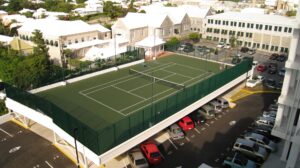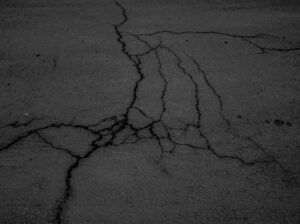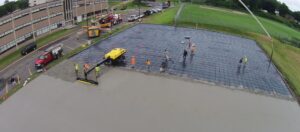 “Should I build an asphalt or post-tension concrete tennis court on my property?” is a question Classic Turf Company of Woodbury, CT, gets asked often.
“Should I build an asphalt or post-tension concrete tennis court on my property?” is a question Classic Turf Company of Woodbury, CT, gets asked often.
Asphalt tennis courts are the most common type of hard-surfaced courts in the tennis industry today, but post-tension concrete courts are gaining in popularity and numbers for several reasons. Why is that?
Things to Know About Asphalt Courts
 What should you know about asphalt tennis courts? They’re usually installed over a crushed stone base using two courses of asphalt known as wearing and binder. While asphalt pavement is flexible, over time it can be affected by freeze/thaw cycles to the point where surface and/or structural cracks develop. That’s why you so often see cracked tennis courts around town– they’re asphalt and despite best intentions, they experience problems. Why, then, do people so readily choose asphalt? Typically, it’s because of the cost: it’s “economical,” aka “cheaper.” That said, over the course of the life of the court, guess what? There’ll be higher maintenance costs, as every few years a company is going to need to be called to come repair cracks and reapply the tennis surfacing system. When this happens, tennis can’t be played because work is being done on the court(s). That “downtime” can mess with a school’s tennis teams plans, for sure. If you’re the type of person who’d rather spend more money now so you don’t have to deal with more issues, problems and headaches later, then post-tension concrete tennis courts are the logical choice.
What should you know about asphalt tennis courts? They’re usually installed over a crushed stone base using two courses of asphalt known as wearing and binder. While asphalt pavement is flexible, over time it can be affected by freeze/thaw cycles to the point where surface and/or structural cracks develop. That’s why you so often see cracked tennis courts around town– they’re asphalt and despite best intentions, they experience problems. Why, then, do people so readily choose asphalt? Typically, it’s because of the cost: it’s “economical,” aka “cheaper.” That said, over the course of the life of the court, guess what? There’ll be higher maintenance costs, as every few years a company is going to need to be called to come repair cracks and reapply the tennis surfacing system. When this happens, tennis can’t be played because work is being done on the court(s). That “downtime” can mess with a school’s tennis teams plans, for sure. If you’re the type of person who’d rather spend more money now so you don’t have to deal with more issues, problems and headaches later, then post-tension concrete tennis courts are the logical choice.
Things to Know About Post-Tension Concrete Courts
What should you know about post-tension concrete tennis courts? They involve installing structural concrete slabs over a prepared base. Concrete slabs, in this case, are reinforced with cables that are tensioned after the concrete is installed. Why is this important? Well, in layman’s terms, this form of tennis court surfacing can handle the freeze/thaw cycle better than asphalt, and, more importantly, it won’t crack! If and when a crack might occur, it’d be a hairline one rather than a big one. Tensioned cables are the key to “crack free courts.”
 Are post-tension concrete tennis courts more expensive to install than asphalt ones? Yes. But, in the long run, they have lower maintenance costs over the life of the court. And here’s some additional good news: post-tension concrete courts have a longer service life than asphalt courts. Did you know Classic Turf Company offers a “20-year crack-free guarantee” on the post-tension concrete courts it installs?
Are post-tension concrete tennis courts more expensive to install than asphalt ones? Yes. But, in the long run, they have lower maintenance costs over the life of the court. And here’s some additional good news: post-tension concrete courts have a longer service life than asphalt courts. Did you know Classic Turf Company offers a “20-year crack-free guarantee” on the post-tension concrete courts it installs?
The Technological Advantage of Post-Tension Concrete Courts
Post-tensioning is a technological advance that has really helped a lot of structures, including tennis courts, last longer and withstand the forces asserted upon them; in other words, “They hold up well to pressure over time.” Post-tensioning is actually a form of prestressing, which has advantages over standard reinforcing steel (aka rebars).
How does post-tensioning benefit a tennis court overall? It reduces and/or eliminates “shrinkage cracking.” No joints (or fewer joints) are needed with this method. If and when cracks form, they’re held tightly together. Concrete slabs can be thinner with post-tensioning, and can be installed over expansive or soft soils. For elevated purposes, when used in things like floors and beams, post-tensioning allows for longer spans.
Over the past couple decades, applications for post-tensioning technology have been numerous. Besides being used in the creation of high quality tennis courts, common applications for post-tensioning include bridges, offshore platforms, circular containment tanks, nuclear containment buildings, parking garages and office buildings.
Want to discuss post-tension concrete tennis courts with Classic Turf Company? Call us today at 800-246-7951. Also, see pictures and read more here.
